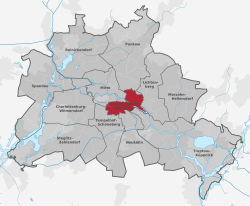Friedrichshain-Kreuzberg
| Friedrichshain-Kreuzberg | ||
|---|---|---|
| Borough of Berlin | ||
|
||
| Coordinates: 52°30′N 13°27′E / 52.500°N 13.450°ECoordinates: 52°30′N 13°27′E / 52.500°N 13.450°E | ||
| Country | Germany | |
| State | Berlin | |
| City | Berlin | |
| Government | ||
| • Mayor | Monika Herrmann (Alliance '90/The Greens) | |
| Area | ||
| • Total | 20.16 km2 (7.78 sq mi) | |
| Population (2012-11-30) | ||
| • Total | 278,579 | |
| • Density | 14,000/km2 (36,000/sq mi) | |
| Time zone | CET/CEST (UTC+1/+2) | |
| Vehicle registration | B | |
| Website | official homepage | |
Friedrichshain-Kreuzberg is the second borough of Berlin, formed in 2001 by merging the former East Berlin borough of Friedrichshain and the former West Berlin borough of Kreuzberg. The historic Oberbaum Bridge, formerly a Berlin border crossing for pedestrians, links both districts across the river Spree as the new borough's landmark (as featured in the coat of arms).
The counterculture tradition especially of Kreuzberg led to a plurality of votes for the Green Party, which is unique among all Berlin boroughs. The local MP Hans-Christian Ströbele is the only Green politician directly elected to the federal Bundestag. While Kreuzberg is characterised by a high number of immigrants, the share of non-German citizens in Friedrichshain is much lower and the average age is higher. The merger between the distinct quarters is celebrated by an annual anarchic "vegetable fight" on the Oberbaumbrücke. Both parts have to deal with the consequences of gentrification.
Friedrichshain-Kreuzberg is suffering from a surge in crime since early 2015, most notably around the former Reichsbahn ground (RAW) and the ASTRA club, resulting in the police advising on Facebook for nightly visitors of the area not to wear any jewellery.
Friedrichshain-Kreuzberg is divided into 2 localities:
At the 2011 elections for the parliament of the borough (Bezirksverordnetenversammlung) the following parties were elected:
Friedrichshain-Kreuzberg is twinned with:
...
Wikipedia



